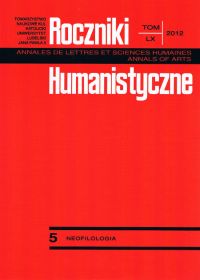Metathesis in the History of English
Abstrakt
Metateza w historii języka angielskiego
Artykuł przedstawia analizę dwu typów metatezy w historii języka angielskiego. Obydwa typy dotyczą zmian, w których uczestniczyła spółgłoska płynna r, i w których można wyróżnić dwie przeciwstawne tendencje. Pierwsza z nich to tendencja zmierzająca do wyeliminowania kombinacji spółgłoskowych typu TR i zastąpienia ich kombinacjami typu RT widoczna na przykład w brid bird, druga to tendencja do wyeliminowania kombinacji RT i zastąpienia ich przez TR, na przykład byrht bryht. Najistotniejszym elementem przedstawionej analizy jest wykazanie, że obydwa rodzaje metatezy wynikają z osłabienia zdolności samogłosek do licencjonowania materiału fonologicznego.
Bibliografia
Bethin, Ch. 1998. Slavic prosody. Language change and phonological theory. Cambridge: Cambridge University Press.
Blevins, J. and A. Garret. 1998. The origins of consonant-vowel metathesis. Language 74.3: 508-556.
Bloomfield, L. 1933. Language. New York: Holt, Rinehart, and Winston.
Campbell, A. 1959. Old English grammar. Oxford: Clarendon Press.
Chomsky, N. and M. Halle. 1968. The sound pattern of English. New York: Harper & Row.
Cyran, E. 2003. Complexity Scales and Licensing Strength in Phonology. Lublin: Wydawnictwo KUL.
Flemming, E. 1996. Laryngeal metathesis and vowel deletion in Cherokee. UCLA Occasional Papers in Linguistics 16: 23-44.
Hock, H. 1985. Regular metathesis. Linguistics 23: 529-546.
Hogg, R. 1977. Old English r-metathesis and generative phonology. Journal of English Linguistics 13: 165-175.
Hogg, R. 1992. A grammar of Old English. I: phonology. Oxford: Blackwell.
Hume, E. 1998. Metathesis in phonological theory: The case of Leti. Lingua 104: 147-186.
Jones, C. 1989. A history of English phonology. London: Longmann.
Jordan, R. 1974. Handbook of Middle English grammar: phonology. The Hague: Mouton.
Lowenstamm, J. (1996). CV as the only syllable type. In J. Durand and B. Laks (eds.) Current trends in phonology: models and methods. Manchester: Europeans Studies Research Institute.
Luick, K. 1914-40. (repr. 1964). Historische Grammatik der englischen Sprache. Stuttgart/Oxford: Bernhard Tauchnitz/ Basil Blackwell.
Milewski , T. 1932. Rozwój fonetyczny wygłosu prasłowiańskiego. Slavia 11: 1-32.
McCarthy, J. 1995. Extensions of faithfullness: Rotuman revisited. Amherst: University of Massachusetts.
Osthoff, H. and K. Brugman. 1878. Vorwort. Morphologische Untersuchungen 1.iii-xx.
Ringe, D. 2006. From Proto-Indo-European to Proto-Germanic. Oxford: Oxford University Press.
Scheer, T. 2004. A lateral theory of phonology. What is CVCV, and why should it be? Berlin and New York: Mouton de Gruyter.
Stieber, Z. 1979. Zarys gramatyki porównawczej języków słowiańskich. Warszawa: Wydawnictwo Naukowe PWN.
Ultan, R. 1978. A typological view of metathesis. In Greenberg, J. (ed.) Universals of human language, vol. 2, Phonology. 367-402. Stanford: Stanford University Press.
Wełna, J. 2002. Metathetic and non-metathetic form selection in Middle English. Studia Anglica Posnaniensia 38: 501-513.
Copyright (c) 2012 Roczniki Humanistyczne

Utwór dostępny jest na licencji Creative Commons Uznanie autorstwa – Użycie niekomercyjne – Bez utworów zależnych 4.0 Międzynarodowe.





